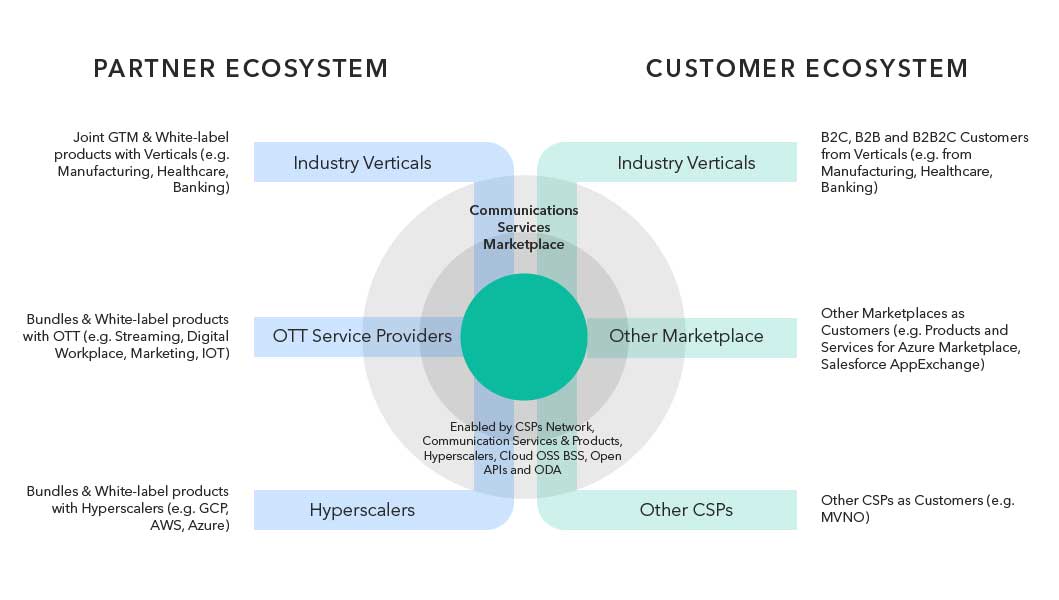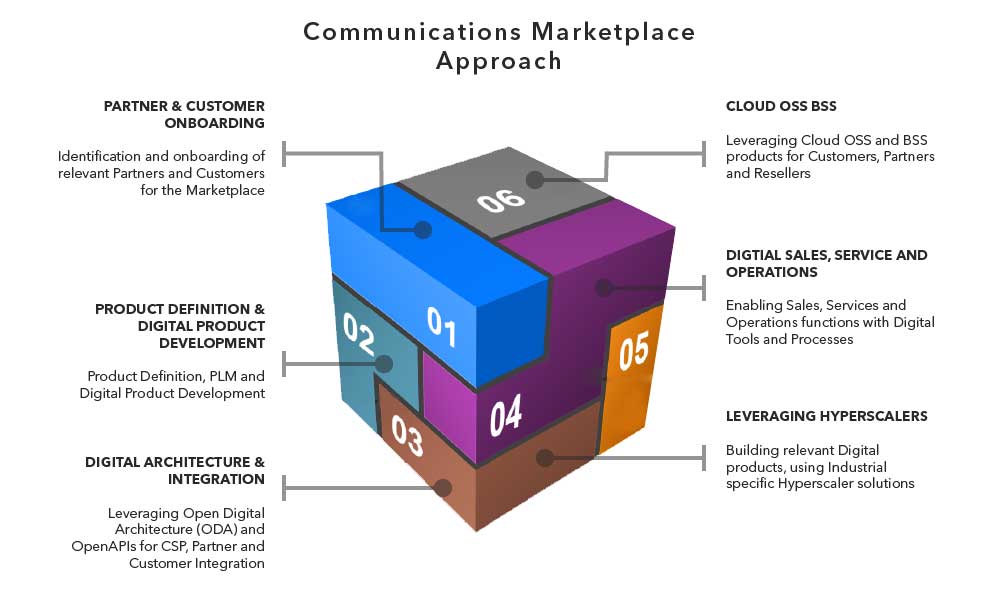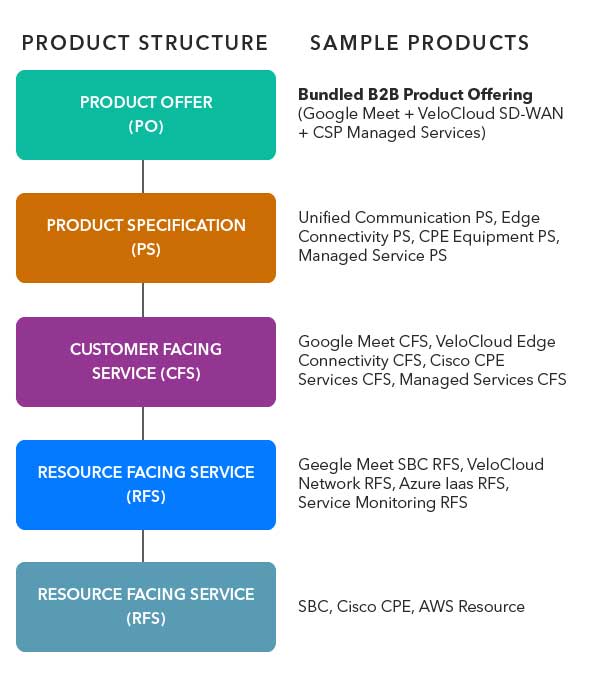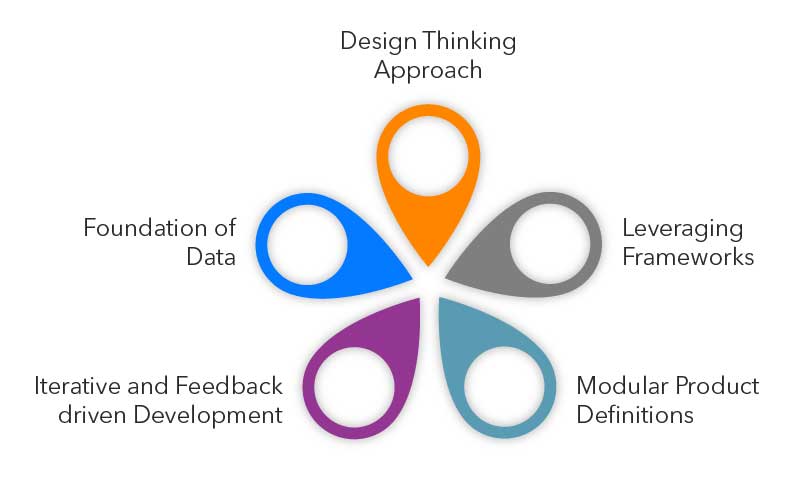OUR THINKING
Communications Services as a Marketplace

Introduction
CSPs, across the globe, have been driving ‘Digital Transformation’ programs for several years, to transform the Enterprise and improve Customer Experience (CX).
Some of the themes for Digital Transformation are as listed in Figure 1 below.

Figure 1: Digital Transformation Themes for Telcos
The COVID-19 pandemic has further accelerated the need for Digital Customer Interactions across industries, and for Telecommunications (Reference: McKinsey Research).
Challenges
The challenges for CSPs are multi-fold, and can be categorized as below:
- Disruptive competition from OTT and other Digital Services providers (DSPs).
- Continuous reduction in traditional Voice and Messaging revenue.
- Hyperscalers like Google, Amazon, and Microsoft are striving to offer Telecom specific products. They are either doing this directly(e.g., Google Fiber) orpartnering with CSPs across the globe (AWS partnership with Verizon).
- Net income continues to remain lowest since 2009 for traditional Telco products and Services.
Need for a Marketplace
Instead of competingwith OTTs and Digital Service Providers, Communication Service Providers (CSPs) need to work-together with them by evolving their Business Models and functioning as a ‘Communications Services Marketplace’.
Operating as a Marketplace will bring in the following benefits:
- Working together with OTT’s instead of competing and sharing the market demand.
- Joint go-to-market(GTM) and White-Label products strategy with industry verticals with embedded communication services (IOT / 5G / SDN NFV).
For e.g.,Industrial IOT based Monitoring Product for a manufacturing customer, or 5G network enabled Tele-Consulting for Healthcare. - Bundled Service Offerings with OTT service providers. For e.g., Managed Digital Workplace Offering leveraging Amazon Chime and SDWAN.
- Improved Customer experience and increased personalization for customers.
- Reduction in operational spend, driven by integrations and digital transformations.
- Global geographical coverage for OTTs to launch CSP network enabled products in any location.

Figure 2: Communications Service Marketplace & Ecosystem
Journey towardsbuildinga Communications Services Marketplace
The transformation, from operating as a standalone CSP to a Marketplace, will need a holistic approach. To implement this strategy, following are the key elements that needs to be considered:
- Partner & Customer Onboarding
- Product Definition & Digital Product Development
- Digital Architecture and Integration
- Cloud OSS BSS
- Digital Sales, Service and Operations
- Leveraging Hyperscalers

Figure 3: Approach for building a Communications Service Marketplace
We recommend the following approach for CSPs to evolve as a Marketplace.
1. Partner & Customer Onboarding
For the marketplace to be truly effective, identifying and onboarding the right partners and customers is an important first step.
CSPs can co-create and co-innovate with partners to create new solutions for Marketplace.
The different parties who canfunction as Partners in this ‘Communications Marketplace’ are:
- Industry Verticals: For e.g., Large / Medium / SME enterprises from industries like Telecom, Manufacturing, Healthcare, Banking, Gaming, and others.
- OTT and Digital Service Providers: These are companies providing Streaming, Digital Workplace, Marketing, IOT solutions. For e.g., Netflix, Microsoft Teams, Nokia Wing, and others.
- Hyperscalers: These are companies that help hyper-scale computing and offer Industry specific solutions for CSPs. For e.g., Amazon AWS, Microsoft Azure and Google GCP.
The different parties who canfunction as Customers in this ‘Communications Marketplace are’:
- Industry Verticals: B2C, B2B and B2B2C Customers from industries like Telecom, Manufacturing, Healthcare, Banking, Gaming, and others.
- Other Marketplaces: CSPs can also collaborate with Partners and create Solutions for other Marketplaces. For e.g., Products and Services for Azure Marketplace, Salesforce AppExchange, and others.
- Other CSPs: CSPs can create Solutions with OTT / Digital Service Providers, for other CSPs. For example, Managed Industrial IoT Solution for MVNOs.
2. Product Definition & Digital Product Development
The Communications Marketplace concept also requires a fresh approach to Product Definition and Product Development Methodology.
- Traditionally, the product lifecycle management (PLM) processes are quite long, and it takes a long time for a new offering to be ready for GTM (go-to-market).
- We recommend CSPs to not just conceptualize Digital Service Offerings, but also look at a new approach for Product’s Ideation to launch lifecycle.
- CSPs need a Digital Product Management strategy, to develop and retireproducts and services at a much greater speed. Like the amazon model, the marketplace enables faster creation and deletion of products and that’s the key to the success of this model.
To co-create and co-innovate products and solutions as a Marketplace, CSPs need to take care of the following:
- Design Thinking Approach
- CSPs need to take an iterative and design thinking-based approach with partners, customers, Hyperscalers and OSS/BSS product vendors to create Marketplace Solutions.
- Design-thinking based approach will allow CSPs to address the right customer needs and build solutions that are Desirable-Feasible-and-Viable.
- Leveraging Frameworks
- CSPs should leverage standardized frameworks like ‘Information Framework (SID)’ from TM Forum.
- This will help CSPs to base Product Definitions on an industry-standards based reference model.
- The information framework will allow CSPs to define a shared Information and Data Model. This will include identification and definition of market, product, customer, service, resource and engaged parties.
- The framework will also help all involved parties to use a common vocabulary. This will further help build the right business processes and applications architecture.
- Modular Product Definitions
- While frameworks like ‘Information Framework’ help with a structure, CSPs also need to follow some recommended best practices.
- Product Catalogue driven Design and Development is important to connect the Marketplace entities together.
- CSPs can follow a modular PSR (product, service, resource) framework, where Quoting / Contracting / Order Creation / Order Fulfilment / Billing and even In-life Service Management are driven from the Product Catalogue
- CSPs can define specific product catalogue layers and orchestration rulesfor scenarios like quoting for 3rdparty services, raising fulfilment request for an external Order Management system.
- For example, it should be possible for a Customer Facing Service (CFS) to be based on a core CSP offering (for e.g., CSPs SDWAN Network), or sourced from a Partner (for e.g., Google Meet’s meeting service).
- Similarly, it should be possible for a Resource (RFS) to be leveraged from a Hyperscaler. For e.g., Infrastructure as a Service (IaaS) as a Resource from Amazon AWS.

Figure 4: Sample SID-based B2B Product Offering for Marketplace
- Iterative and Feedback driven Development
- The product definitions and product lifecycle management (PLM) should be an iterative exercise and driven based on continuous feedbacks and learnings.
- Considering the products and solutions will be co-created with partners, its important for the product development processes to iteratively improve upon the feedbacks collated from partners and customers.
- Foundation of Data
- Finally, CSPs need to have a strong foundation of Data and Analytics throughout the process.
- This is important to have the right data, analytics, and intelligent insights available, to make the right product decisions.

3. Digital Architecture and Integration
To build new digital products and services, it is also important for CSPs to organize their IT estate into a digital architecture and integration pattern.
- We recommend TM Forum’s Open Digital Architecture (ODA) and Open APIs based architecture framework (source: https://www.tmforum.org/oda/).
- Open Digital Architecture (ODA) is a blueprint for modular, cloud-based, open digital platforms that can be orchestrated using AI.
- Digital Architecture will help CSPs and partners with the following:
- Business Capability and Business Architecture based functions and components
- Standard business processes to align IT systems and Operations. ODA Architecture leverages TM Forum’s eTOM framework for this.
- Standard Product / Information and Data Model. ODA Architecture leverages TM Forum’s Information Framework (SID) for this.
- Digital integration patterns based on TM Forum’s Open APIs.
4. Cloud OSS BSS
According to TM Forum’s report (source: Cloud Native OSS/BSS), modernizing OSS/BSS processes to use cloud-native architectures will allows CSPs to create greater operational efficiencies. It also helps them develop new services in shorter innovation cycles and generate revenue faster.
A quick look at the OSS BSS Technology products in 2021, and it’s clear that most IT COTS Products have developed industry-specific verticalized products for CSPs.
- The market for Cloud based low-code platforms (like Salesforce, ServiceNow, Appian) is expected to reach $46.4 billion by 2026) (Source: KBV Research).
- Products like Salesforce (CRM) / Salesforce Industries CPQ (earlier called Vlocity) and ServiceNow have launched vertical industry solutions for CSPs.
- To drive digital transformation, Telco’s need to leverage these verticalized product offerings.
- This will help bring best practices across IT implementation programs and help to bring down the cost of building and developing custom in-house tools.
5. Digital Sales, Service and Operations
With a new ‘Marketplace’ based business modeland digital service offerings, it is also important for CSPs to enable their Sales, Service and Operations functions with digital tools and processes.
- CSPs and Partners’Sales, Marketing, Pricing, Service and Operations functions will need enablement for the new products, training on the digital touchpoints and understanding the new Marketplace business model.
- It is important for User teams from Sales / Service and Operations to be involved early-on to be able to influence the Product Development lifecycle for the actual user needs.
- Sales, Marketing, Pricing teamsand Legal, will need enablement for Marketing and Sales processes in the new Marketplace ecosystem.
- The teams will also need training on the Digital OSS and BSS systems, so that they have the right tools to get their work done. For example, creating Quotes on tools like Vlocity / CloudSense.,or for tracking orders on tools like Hansen / CienaBluePlanet.
- Similarly, Service and Operations teams will need to understand the Service Monitoring / Service Managementprocesses and enabler IT systems. For example, leveraging CSM and ITSM capabilities on ServiceNow, or working with Service Desk eBonding using ServiceNow.
6. Leveraging Hyperscalers
In the context of a ‘Communications Marketplace’, it is important for CSPs to leverage CSP-specific solutions developed by hyperscalers like Amazon AWS, Microsoft Azure and Google GCP.
- To do this, we recommend making hyperscalers an equal partner in the marketplace and co-creating / co-innovating solutions with them.
- Hyperscalers like Google Cloud, Amazon AWS and Microsoft Azure are already building digital technology and operations stacks for Telcos.
- For example, AWS and Verizon have integrated Verizon’s 5G Edge MEC platform with AWS Outposts, a fully managed service that offers the same AWS Infrastructure, AWS services, APIs, and tools to virtually any data center, colocation space, or on-premises facility for a consistent, hybrid experience.
Summary
In summary, it is imperative for communication service providers (CSPs) to evolve as ‘Communications Services Marketplace’ and work on co-creation and co-innovation of digital products and services, together with hyperscalers / Cloud OSS BSS providers and OTT service providers.
Communications Services Marketplace approach will help CSPs and ecosystem partners to stay relevant in the market, launch new digital services, drive new revenue streams, and increase customer stickiness.
We hope the approaches proposed in this paper will act as a reference for the setup &execution of a Marketplace solution for CSPs, hyperscalers and Digital Service Providers.
References
- https://www.mckinsey.com/business-functions/strategy-and-corporate-finance/our-insights/how-covid-19-has-pushed-companies-over-the-technology-tipping-point-and-transformed-business-forever
- https://www.kbvresearch.com/low-code-development-platform-market/
- https://www.mckinsey.com/industries/retail/our-insights/the-how-of-transformation
- https://www.tmforum.org/
- https://www.tmforum.org/oda/
- https://inform.tmforum.org/research-reports/cloud-native-oss-bss/



